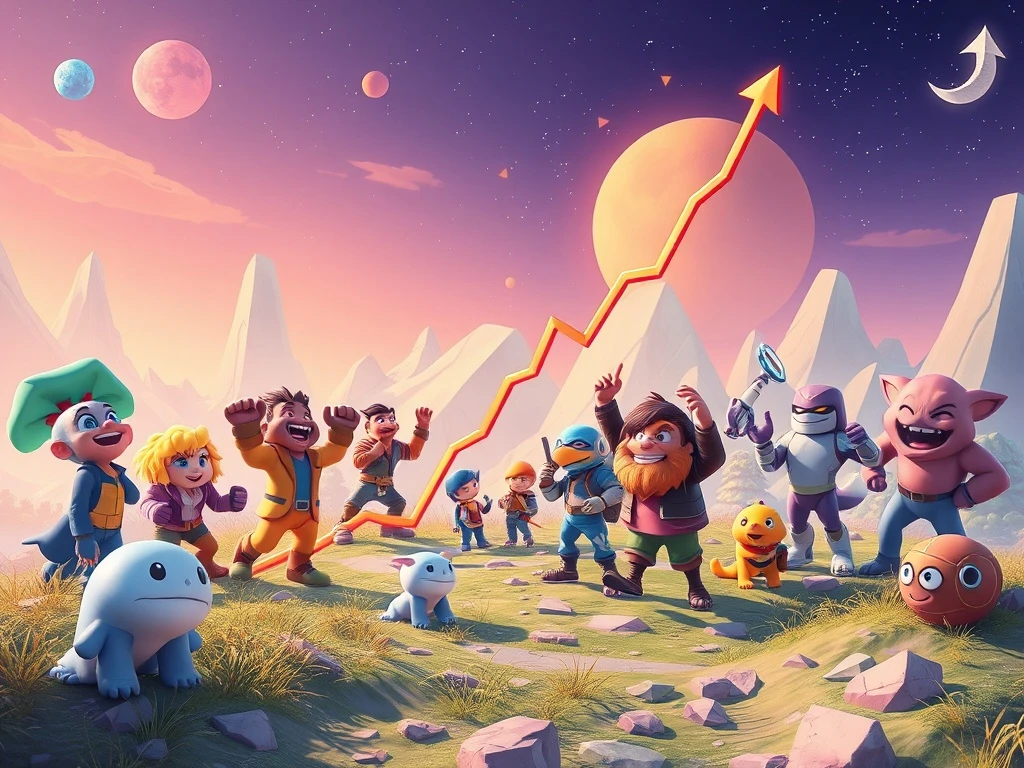Remarkable Web3 Gaming: Funding Soars 94% as ‘Fun-First’ Games Attract Investors

The landscape of digital entertainment is undergoing a significant transformation. Crypto enthusiasts and investors are witnessing a remarkable resurgence in **Web3 gaming** funding. After a period of cooling, investments have surged, indicating a pivotal shift in focus within the sector. This renewed interest highlights a maturing industry, prioritizing engaging gameplay over speculative mechanics.
The Resurgence of Gaming Investments in Web3
July marked a turning point for **gaming investments** in the Web3 space. Funding soared to an impressive $60 million, representing a 94% jump from previous months. This significant increase reverses a three-month lull that saw capital inflows diminish. While March still holds the record for this year’s highest funding at $69 million, July’s performance signals robust renewed confidence.
According to DappRadar, a leading blockchain analytics platform, capital is now flowing strategically. Investors are primarily targeting projects that demonstrate:
- Proven teams with established track records.
- Strong intellectual property (IP) that can attract and retain users.
- Robust infrastructure capable of supporting multiple games.
This targeted approach suggests a departure from the speculative ‘gold rush’ mentality of earlier phases. Instead, the market favors stability and long-term viability. However, this shift also presents challenges for smaller studios. Projects lacking traction or sustainable economies are struggling, often closing or pivoting their strategies. DappRadar analyst Sara Gherghelas aptly describes this as a “Darwinian stage” for Web3 gaming, implying tough competition but ultimately fostering a healthier, more stable foundation for the future.
‘Fun-First’ Crypto Games: A Paradigm Shift
A crucial development driving this investment surge is the pronounced shift towards ‘fun-first’ **crypto games**. Previously, many blockchain games prioritized ‘play-to-earn’ mechanics, often at the expense of engaging gameplay. Now, investors and developers are realizing that entertainment value is paramount for mass adoption. Blockchain elements are increasingly seen as optional enhancements rather than the core appeal.
This evolution means that games are built with intrinsic enjoyment in mind, while blockchain components serve as a seamless backend. These elements might include:
- Integrated wallets for secure asset management.
- Artificial intelligence (AI) tools to enhance gameplay or non-player characters.
- Cross-chain systems enabling interoperability across different blockchain networks.
This approach stands in stark contrast to earlier models, where blockchain integration often felt like an afterthought. Jeffrey Zirlin, co-founder of Sky Mavis (creators of Axie Infinity), shared a similar perspective earlier this year. He noted that investors are no longer blindly funding “Axie killers” – projects that promised to be the next big Web3 game but failed to deliver on gameplay or sustainable models. This signifies a maturing understanding within the investment community regarding what truly drives user engagement and longevity in the gaming space.
The Maturation of Blockchain Gaming
The **blockchain gaming** sector has undeniably entered a more mature phase. What was once a niche driven by speculative asset trading is transforming into a legitimate segment of the broader gaming industry. Investor interest, which had cooled earlier in the year amid shifts towards real-world assets and AI, has now refocused on core gaming principles.
This maturity is characterized by a strong emphasis on:
- Quality gameplay experiences that rival traditional titles.
- Sustainable economic models that support long-term player engagement.
- Scalable infrastructure designed to handle a growing user base.
The projects currently thriving are laying essential groundwork for future growth. They position Web3 gaming as one of the most resilient and forward-looking sectors within the blockchain ecosystem. Furthermore, studios that secure funding today and successfully build sustainable tokenomics, while also retaining users, could find themselves in a prime position when broader macroeconomic conditions improve, potentially around 2026. This long-term vision underpins the current strategic investments.
Expanding User Base: Daily Unique Active Wallets Rise
Beyond funding, user activity also points to the sector’s health. **Blockchain gaming** reached 4.9 million daily unique active wallets in July. This figure represents a 2% increase from June. Importantly, this growth positioned blockchain gaming as the leader within the decentralized application (dApp) ecosystem for the month. While other sectors experienced a cooling period, gaming not only held its ground but expanded its audience.
Industry leaders are playing a crucial role in maintaining player interest. Top Web3 titles are consistently releasing major updates, new content, and engaging events. These efforts help to keep players invested and active within their respective game worlds. This sustained engagement is vital for building robust, long-term communities around these digital experiences.
DappRadar’s analysis confirmed that July showcased continued momentum for Web3 gaming. The sector reached nearly five million monthly players, demonstrating its ability to grow even when other areas of the blockchain industry experienced slowdowns. Gaming still dominates the industry in terms of user activity, though the gap with AI applications is narrowing. The dynamic competition between these two innovative sectors will undoubtedly be a key trend to monitor in the coming years.
Sustainable Play-to-Earn Models and Future Outlook
The evolution of **play-to-earn** models is central to the industry’s newfound maturity. Early play-to-earn games often suffered from unsustainable economies, where token emissions outpaced utility or demand, leading to rapid devaluations. The current focus is on creating balanced ecosystems where players earn rewards through genuine skill, participation, and contribution, rather than purely speculative activities.
This shift emphasizes:
- In-game economies that are self-sustaining through various mechanisms.
- Tokenomics designed for long-term value appreciation and utility.
- A focus on retention strategies that keep players engaged for extended periods.
Looking ahead, the industry anticipates fewer but stronger Web3 game releases. Cross-platform launches are also expected to become more common, broadening accessibility. Furthermore, brand-driven titles will likely emerge, leveraging established intellectual property to attract mainstream audiences. The previous hype cycles may be behind us, but what is emerging is a more grounded, resilient foundation. This new phase could lead to a wave of Web3 gaming that is larger and more robust than anything seen before, truly integrating digital ownership and blockchain technology into compelling entertainment experiences.







